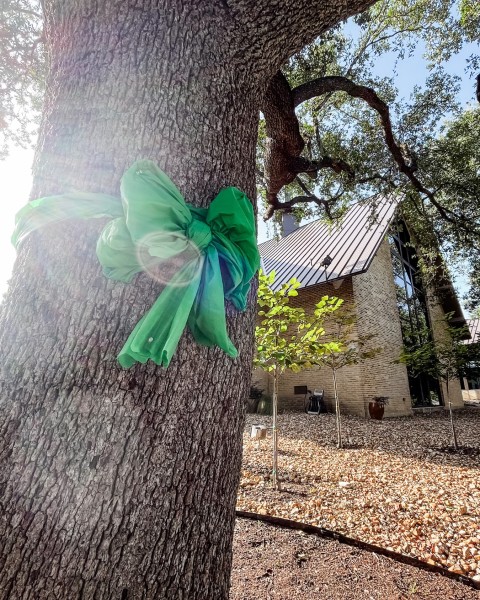Episcopal Diocese of West Texas prepares for long-term response after deadly floods

Green ribbons have become a symbol of shared grief in the aftermath of the July floods in Texas.(Episcopal Diocese of West Texas via Facebook)
The San Antonio-based Episcopal Diocese of West Texas is assessing how best to assist with long-term recovery efforts after July 4 floodwaters killed at least 138 people in the Texas Hill Country.
“There’s going to be a lot of rebuilding to do. There’s going to be a lot of counseling to do. There’s going to be a lot of need in the long haul financially,” West Texas Bishop David G. Read said in a phone interview. “Right now, we’re focusing on financial support and then we’ll partner with other agencies.”
The Diocese of West Texas has launched a donation webpage, as has Episcopal Relief & Development, and St. Peter’s Episcopal Church in Kerrville, Texas.
The diocese also purchased an RV for rescue workers to use for search efforts and to assist people who’ve lost their homes in the floods, the bishop added. St. Peter’s is setting up a satellite site in Hunt, a small town about 12 miles northwest of Kerrville, to do ministry work with rescue workers and assist with search efforts. The church, which is located two blocks from the Guadalupe River, also is recruiting volunteers to assist with rebuilding efforts.
St. Peter’s, which averages about 300 worshippers on Sundays, is in Kerr County, where most of the fatalities occurred when the Guadalupe River swelled and breached its banks along 40 miles. Seven parishioners, including two adults, a family of four and an 8-year-old girl, died in the floods, Read said.
The 8-year-old girl, Renee Smajstrla, was among the 27 campers and staff who died at Camp Mystic, an all-girls nondenominational Christian camp located east of Kerrville along the river.
St. Peter’s has been open daily for residents seeking a place for prayer as the community grieves. Amid the recovery, the church’s worship schedule will continue as normal, and Read said that 90 students were enrolled in vacation Bible school, which started on July 14.
As early as July 2, emergency management officials warned of potential flooding heading into Independence Day. The deadly flood began early July 4 when a slow-moving storm brought heavy downpours to the region, dropping as much as 15 inches of rain on parts of Kerr County and causing parts of the Guadalupe River to rise as high as 30 feet in 45 minutes. Near Camp Mystic, the river’s water level peaked at 37.52 feet, surpassing the highest recorded crest in 1932.
The National Weather Service issued a flash flood warning in central Kerr County and northwest Bandera County that night shortly after 1 a.m., while many people were asleep. Richard “Dick” Eastland, longtime Camp Mystic co-director, began evacuating the hundreds of campers and staff members about 45 minutes later. He died while trying to rescue girls stuck inside one of the cabins near the river.
To provide counseling for children who’ve been impacted by the floods, the diocese is coordinating with the San Antonio-based nonprofit Children’s Bereavement Center of South Texas, which offers counseling and support to children and families mourning the death of loved ones. The bereavement center established a permanent office at St. Philip’s Episcopal Church in Uvalde, where, in 2022, 19 children and two adults were murdered in a mass shooting at Robb Elementary School.
Amid the recent tragedy in his diocese, Read said he’s lately been turning to Psalm 121:1-2: “I lift up my eyes to the hills—from where will my help come? My help comes from the Lord who made heaven and Earth.” The psalm is quoted in a letter he and West Texas Bishop Suffragan Angela Cortiñas wrote to the diocese on July 5 in the floods’ immediate aftermath.
“It seems like the right message for what’s happening [in the Texas Hill Country],” he said. —Episcopal News Service




